Project Diary
Stay informed on AgroStrat activities and results
2015
May 2015
- In the framework of Action A3, 190 soil samples from the first pot experiment are being analyzed for soil physicochemical parameters. The second soil pot experiment with two indicator plants, lettuce and dill was established. The experimental design includes three treatments: a) control without fertilization, b) chemical fertilization and c) compost application (compost derived from pistachio waste with zeolite-Action A3). Thus, the number of plants for each pot experiment was 3 treatments x 3 plants x 10 soil types=90 plants. Doses of compost and fertilizers were determined based on recommendations given by Cultivation Management Software for each soil type and test crop.
- Finalization the algorithm that is responsible for the connection of the CMMT (server) with the farmers (Action B2).
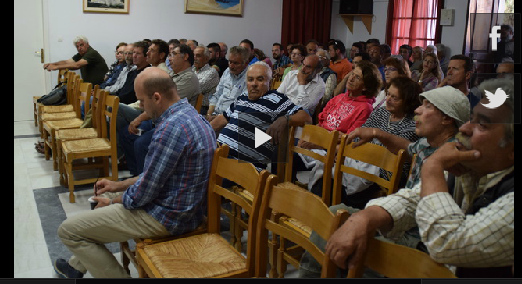
- TUC conducted sensitivity analysis of the first obtained water-related risk maps of the pilot area. Inventory data building (update) of current Pistachia vera L. cultivation practices and waste utilization for LCA modelling based on the first results of the corresponding questionnaires. Reactive transport modelling of the pilot area based on results of water chemical analyses and the (hydro)geological profile of Aegina (Action C1).
- On 20 May an event was organized by the Agricultural Organization of Aegina in order to inform local farmers regarding the Cultivation Management Software of AgroStrat. More than 70 farmers participated in the event while many of them were trained and used the software (Action D1). The event was broadcasted by Aegina Portal Web TV. Watch the event here.
- After the composting training workshop in September 2014, many farmers in Aegina composted their wastes. Samples collected from 5 composts and were transferred to the lab of SSIA for analysis.
April 2015
- The soil pot experiments as regards the impact of wastes on soil properties in greenhouse were completed. Soil samples, approximately 150, were collected for chemical analysis. The second soil pot experiment with indicator plants has been established. Soil pots were transferred in greenhouse of SSIA and lettuce and dill plants will be planted in the beginning of May (Action A3).
- Soil advisory algorithms integration to the sub-module “Advisory”. Development of all the necessary classes and data structures. Integration of geospatial GUI elements (maps API) to the field management sub-module,
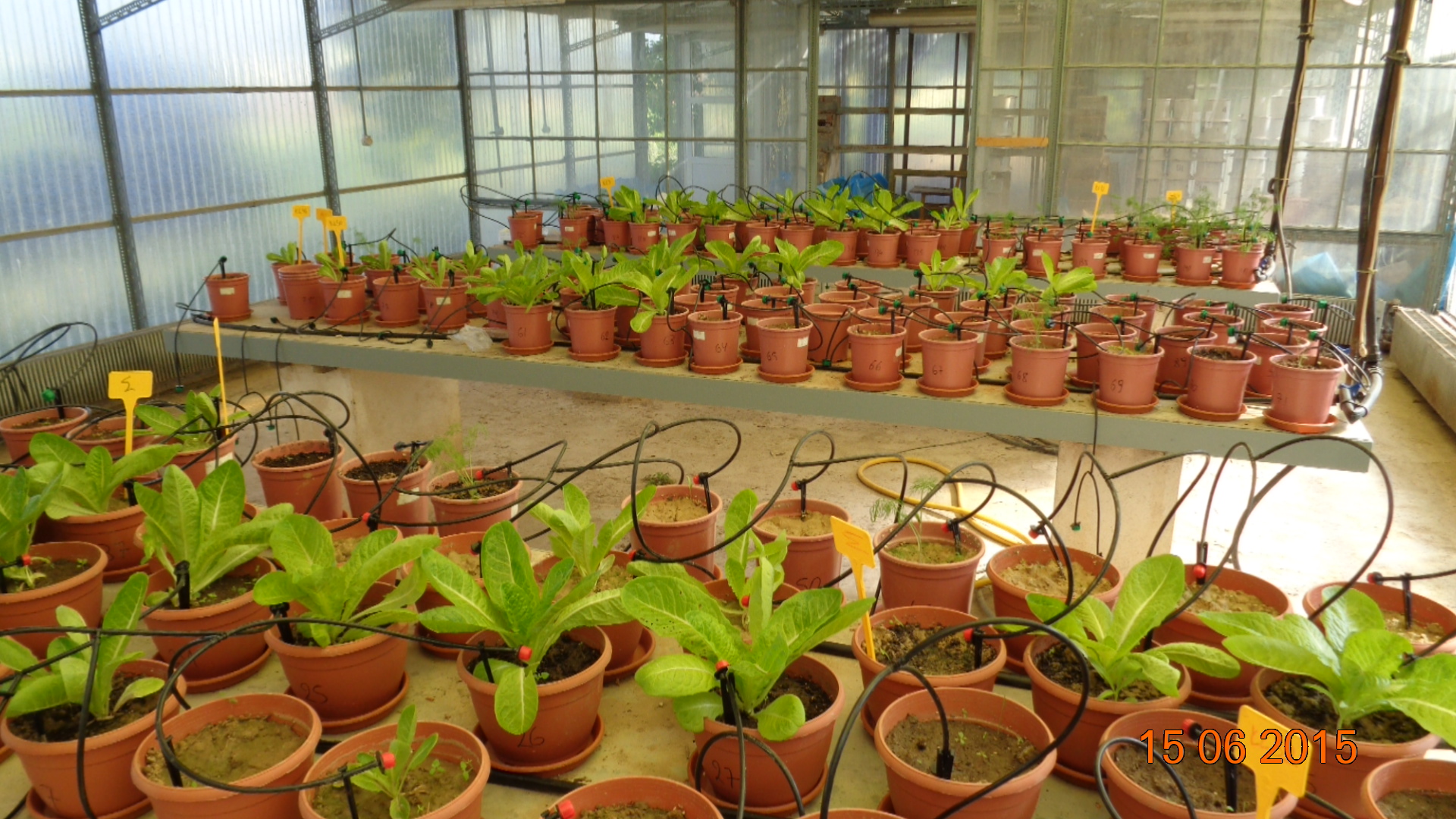 providing users a user friendly interface, in order to store the location coordinates as data for each of their fields (Action A4).
providing users a user friendly interface, in order to store the location coordinates as data for each of their fields (Action A4).
- In the framework of Action B2, initial development of the module that is responsible for the connection of the CMMT (server) with the users (farmers), running the Cultivation Monitoring Software
- Econometric analysis of the energy balance of pistachios cultivation (Action C1).
March 2015
- SSIA continued the soil pot experiments in greenhouse in the framework of Action A3. Pots with soils are regularly irrigated at field capacity while weed control is taken place. Daily temperature and air humidity are recorded. A new experiment with test plants is designed to be established next month, in collaboration with the coordinator Dr. M. Doula. The experiment will assess the fertilization recommendations given by the fertilization model. It includes 10 soil types, 2 main market crops and 3 fertilization treatments (conventional fertilization, chemical fertilization, application of pistachio compost treated with zeolite as prepared in the framework of the same Action).
- As for activities foreseen in Action A4, design analysis of the «Αdvisory» submodule (downloable rational fertilization instructions on data entry for cultivation fields and the practices users want to apply - soil remediation using organic materials) and development of the field and measurement management based on the above design analysis took place.
- Design and development of a Graphical User interface (GUI) for the field and measurement management (Action A4).
- Continuation of CMMT (server) application design and development for supporting the GIS-LIS map data acquired (Action B2).
- Inventory data building (update) of current Pistachia vera L. cultivation practices and waste utilization for LCA modelling based on the first results of the corresponding questionnaires (Action C1). Reactive transport modelling of the pilot area based on results of water chemical analyses and the (hydro)geological profile of Aegina and seasonal data analysis of the water and soil sampling results for risk evaluation of the pilot area (Action C1).
February 2015
- IMS continued the design analysis, the development of the quality rating submodule, as well as the design and the development of a friendly Graphical User interface (GUI) for the submodule which is part of the Monitoring Tool Software (Action A4). Documentation and manual creation for the Monitoring Tool Software demo version installation and software package (Action A4).
- Dr. A. Sarris (IMS) and Dr. M. Doula (SSIA-BPI) finalized the design of the overall software algorithm used in the Soil/Water/Compost Evaluation & Fertilization process and details of the GIS-LIS and its expansion to other Med areas during many meetings between 9-20 February when the coordinator was in Rethymno, Crete. The IMS-FORTH team finalized the algorithm of fertilization model. This part of the software will be evaluated by Dr. V. Kavvadias (SSIA).
- IMS provided support and remote assistance during the setup of the meteorological station data retrieval infrastructure for incorporation into the project website.
- Integration of the meteorological data retrieved from the meteorological station that is being installed in Aegina, to the website of Agrostrat. Implementation of the data display models, through charts and Rose diagrams, in order to display the meteorological indicators in an easy and friendly to use way. The display of those data is supported in 2 different languages (Greek-English).
- In the framework of Action B2, IMS continued the design and the development of the CMMT (server) application for supporting the GIS-LIS map data acquired.
- In the framework of Action C1, TUC continued the activities of previous month, while statistical analysis of suitable social-indicators for sustainable Pistachia vera L. cultivation in Aegina took place.
- Re-organization actions of Web-site inventory based on the external monitor recommendations and server set up to host software installation and future updates took place in the framework of Action D1 by IMS. Moreover, web based installer for the demo version made available for download on Project website.
- Several meetings between 9-20 February took place between the coordinator and Dr. A. Sarris and IMS team as well as with Prof. K. Komnitsas and TUC team. Several issues related to the project were extensively discussed (Actions E1 and E2).
January 2015
- Soil pot experiments in greenhouse at the premises of SSIA were initiated in the framework of Action 3. The partners will study the effect of waste (solid and wastewater) on different soil types. For this, soils of ten different soil types were transferred to greenhouse.
- In the framework of Action A4, IMS designed an analysis and developed quality-rating submodule for composts application on soil (data entry of chemical analysis results for soil/irrigation water/compost and other organic additives and evaluation of the parameters in accordance with the EU and international standards). A friendly Graphical User interface (GUI) for the above submodule (part of the Monitoring Tool Software) was designed and developed, as well. A beta implementation (.exe installer) of the above software is compiled in both Greek and English languages
- Design of the CMMT (server) application for supporting the GIS-LIS map data acquired (Action B1).
- TUC in the framework of Action C1, built a scenario of current Pistachia vera L. cultivation practices and waste utilization for LCA modelling based on the first results of the corresponding questionnaires.
- Data analysis and Interpretation of (1) the water and soil sampling results for risk evaluation of the pilot area using geostatistics methods as well as of (2) questionnaires concerning LCA of Pistachia vera. L cultivation, adapted to the different target audiences (stakeholders, farmers, policy makers, public-at-large, agricultural associations, scientists, students).
- Reclassification analysis of suitable social-indicators for sustainable Pistachia vera L. cultivation in Aegina in the framework of Action C2.Data analysis and Interpretation of questionnaires concerning socio-economic impacts of the project, adapted to the different target audiences (stakeholders, farmers, policy makers, public-at-large, agricultural associations, scientists, students).
- A series of Actions took place for project dissemination (Action D1):
- The 4th Newsletter of the project was sent to more than 400 recipients (in Greek and in English).
- The web site of the project was enriched with recent data and information.
- Website statistics, i.e. overall and unique visits / page views are directly embedded to the website through Google Analytics API using a friendly user interface (with Google Charts JS API).
- Several website module updates were included for “basic page”, “news article” elements for assisting editing and file/image upload capabilities.
- Infrastructure update took place for the Agrostrat website, which is now hosted in a new devoted webserver of IMS-FORTH.
- Cooperation with project coordinator and TUC beneficiary for security update actions for the partners’ area webpage section, in particular access permissions and control for authenticated users.
- Several webpage optimization actions took place to speed up the website responsibility.
2014
December 2014
- The greenhouse pot experiments were initiated at SSIA premises (Action A3).
- The LIS_GIS system is under evaluation and soon will be incorporated in the decision-making tool of AgroStrat (i.e. the software of Action A4).
- A meeting took place at IMS's premises in Rethymnon, Crete, between the project team of IMS and SSIA (Action E2). The aim of this meeting was to finalize the output of the fertilization software model. The soil evaluation tool is going to be available in public next January.
- Design analysis of soil, water and compost analysis modules for the monitoring tool software (Action A4).
- Design and development of modules/routines for the water and compost submodel (Action A4).
- Development of the monitoring tool software (Action A4).
- Scenario building of alternative P. vera L. cultivation practices and waste utilization for Life Cycle Analysis modelling based on site-specific conditions (Action C1).
- In the framework of Action C1, energy input-output calculations of pistachios cultivation / Econometric analysis using statistical package (Eview), data analysis and Interpretation of questionnaires concerning Life Cycle Analysis of P. vera. L cultivation, adapted to the different target audiences (stakeholders, farmers, policy makers, public-at-large, agricultural associations, scientists, students).
- Data analysis and Interpretation of questionnaires concerning socio-economic impacts of the project, adapted to the different target audiences (stakeholders, farmers, policy makers, public-at-large, agricultural associations, scientists, students). Final analysis of suitable social-indicators for sustainable pistachio vera L. cultivation in Aegina (Action C2).
November 2014
- Soil thematic maps were developed and validated (Action A2).
- The output for soil characteristics in the fertilization model was reviewed by SSIA and sent to IMS (Action A4).
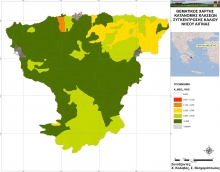
- Legislative restrictions regarding the use of organic amendments for soil fertilization/improvement were reviewed and sent to IMS to be integrated into the decision-making tool (i.e. the software of Action A4). Consultancy regarding the use of different types of organic amendments (compost, manures and pistachio wastes) will be provided by the tool considering soil and amendments chemical analyses, the thematic maps, area geomorphology and the purpose of use (fertilization, soil improvement, disposal). All the above will be integrated in the GIS-LIS as foreseen in the proposal.
- The experimental design for pot experiments of Action A3 were finalized. Ten different soil types will be placed in pots and mixed at different proportions with composts and wastes. Soils will be periodically analyzed for determination of their properties in the beginning in the middle and in the end of the experimental period. The experiments will be carried out in the greenhouse of SSIA (Action A3).
- Design analysis of soil and water analysis modules for the monitoring tool software (Action A4).
- In the framework of Action A4, design and development of modules/routines for the soil and water submodel and design and development of the monitoring tool software graphical user interface (GUI).
- Development of preliminary risk map of the pilot area for irrigation purposes using ArcGIS 10.1 and the IWQ methodology (Action C1).
- Development of water-related risk map of the pilot area using ArcGIS 10.1 and the Agricultural DRASTIC model. Validation and Sensitivity analysis of first results (Action C1).
- Scenario building of alternative P. vera L. cultivation practices and waste utilization for Life Cycle Analysis modelling based on site-specific conditions (Action C1).
- Data analysis and Interpretation of questionnaires concerning Life Cycle Analysis of P. vera. L cultivation, adapted to the different target audiences (stakeholders, farmers, policy makers, public-at-large, agricultural associations, scientists, students). Final analysis of suitable social-indicators for sustainable P. vera L. cultivation in Aegina (Action C2).
October 2014
- Design analysis of modules for the monitoring tool software-soil analysis (Action A4).
- Design and development of modules/routines for the soil submodel (Action A4).
- Design and development of the monitoring tool software (Action A4).
- Scenario building of alternative P. vera L. cultivation practices for Life Cycle Analysis modelling based on site-specific conditions (Action C1).
- In the framework of Action C2, data analysis and Interpretation of questionnaires concerning Life Cycle Analysis of P. vera. L cultivation, adapted to the different target audiences (stakeholders, farmers, policy makers, public-at-large, agricultural associations, scientists, students).
- Preliminary analysis of suitable social-indicators for sustainable P. vera L. cultivation in Aegina (Action C2).
September 2014
August 2014
July 2014
- The 3rd Newsletter was prepared and sent to the recipients from the database of AgroStrat (Action D1).
- Two workshops in Aegina are organized. i.e. an informative workshops and a composting training workshop (Action D1).
- The Institute of Mediterranean Studies validated various parameters of the fertilization model (Action A4).
- Scenarios related to the methodology of fertilization, season of fertilization, number of applications and form of fertilizers are being developed-Cooperation between SSIA and IMS (Action A4).
- The model output of the irrigation water quality is under preparation-Cooperation between SSIA and IMS (Action A4).
- Experimental validation and verification of the field equipment tools (Action A2)
- The development of the Software monitoring tool initiated (Action A4).
- Development of water-related risk map of the pilot area using ArcGIS 10.1 and the DRASTIC model (Action C1).
- Reactive transport modelling of the pilot area based on results of water chemical analyses and the geological profile of Aegina (Action C1).
- Analysis of suitable social-indicators for sustainable P. vera L. cultivation that have been adopted in other Mediterranean countries (Action C1).
- Final creation of a questionnaire concerning social-economic impact of P. vera L. cultivation, adapted to the different target audiences (Action C2).
June 2014
May 2014
April 2014
- Germination tests were performed for the one of the composts prepared in the framework of Action A3.
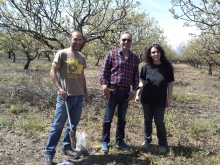 The coordinator visited the pistachio producers in Fhtiotida prefecture (two associations) and presented project’s aims. The two associations were satisfied from the anticipated outcomes and expressed their interest to implement the software that will be developed. It is also agreed to visit together with the coordinator and the team Leaders of IMS and TUC the Regional Governor to present the project and ask his support for the implementation of AgroStrat also in Fthiotida.
The coordinator visited the pistachio producers in Fhtiotida prefecture (two associations) and presented project’s aims. The two associations were satisfied from the anticipated outcomes and expressed their interest to implement the software that will be developed. It is also agreed to visit together with the coordinator and the team Leaders of IMS and TUC the Regional Governor to present the project and ask his support for the implementation of AgroStrat also in Fthiotida.- Pistachio producers from Larisa (Thessaly prefecture, Central Greece) contacted the coordinator and a meeting was organized to take place after 15 May.
- All the procedures, algorithms, thematic maps (from SSIA and TUC), fertilization and irrigation consultation, assessment of soil and water quality and wastes/composts characteristics developed so far were synthesized, with the legislative recommendations regarding landspreading of wastes. An integrated algorithm will be processed in cooperation with IMS and TUC and will take the form of the GIS-Land Information System to be delivered in the framework of Actions A3, A4 and B2.
- Initial prototyping of the Software monitoring tool (soil analysis) by IMS in the framework of Action A4.
- Exploration of data for Risk map creation using ArcGIS 10.1. Integration and combination of multiple input GIS datasets (Action C1).
- Energy input-output calculations of pistachios cultivation / Econometric analysis using statistical package (Eview) in the framework of Action C1.
- Selection of suitable social-indicators for sustainable pistachio vera L. cultivation that have been adopted in other Mediterranean countries (Action C2).
March 2014
- Project team (M. Doula, V. Kavvadias, K. Dimopoulos and A. Tsoutsikos) visited Aegina between 18 and 22 March for soil sampling (Action A2).
- The software of the meteorological station was sent to IMS and actions will be taken to install a server in Aegina. By this way meteorological data will be directed to IMS, incorporated to the software of action A4 and also be available on the web site of AgroStrat in real time.
- Additional actions were taken for Content Management System (CMS) support. Software monitoring tool requirement & design analysis was continued during this month in the framework of Action A4.
- Preliminary exploration of data for Risk map creation using ArcGIS 10.1. Integration, georeferencing and interpretation of available GIS data (Action C1).
- Preliminary exploration of geochemical data for site contamination modelling (Phreeqc) in the framework of Action C1.
- Final modification of the existing questionnaire concerning LCA of pistachio production, adapted to the different target audiences (stakeholders, farmers, policy makers, public-at-large, agricultural associations, scientists, students) in the framework of Action C1.
- Final creation of a preliminary questionnaire concerning social-economic impact of pistachia vera L cultivation, adapted to the different target audiences (Action C2).
February 2014
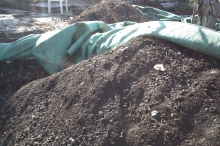
- The composts prepared by mixing wastes, manure and zeolite is almost mature and for this it was transported at SSIA’s premises and it will be included in the pots experiments (Action A3).
- Dr. M. Doula, Mr. K. Dimopoulos and Mr. A. Tsoutsikos collected water samples from Aegina between 3 and 6 February (Action A2).
- Additional changes to the website took place by IMS (Action D1).
- Preliminary exploration of data for Risk map creation (Action C1).
- Preliminary exploration of geochemical data for site contamination modelling (Phreeqc) in the framework of Action C1.
- Modification of the existing questionnaire concerning LCA of pistachios vera. L, adapted to the different target audiences (stakeholders, farmers, policy makers, public-at-large, agricultural associations, scientists, students) in the framework of Action C1.
- Final creation of a preliminary questionnaire concerning social-economic impact of pistachios vera. L cultivation, adapted to the different target audiences (Action C2).
January 2014
- Composting is well processed in Aegina (Action A3).
- A sampling team of SSIA (Doula, Kavvadias, Dimopoulos and Tsoutsikos) collected 8 different Greek soil types from Peloponnese, based on data available in SSIA’s archives
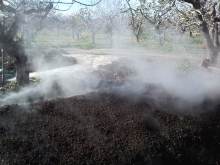
for the experiments of action A3 (almost 770Kg of soils were collected). Eleven different soil types have been collected in total (8 from Peloponnese and 3 from Aegina).
- Data regarding irrigation water quality, parameters and assessment of water quality were sent to IMS to be included in the software of action A4. Similar data were sent for soil parameters.
- Dr. Doula and Dr. Kavvadias visited TUC and IMS on 23 and 24 January, respectively. The beneficiaries discussed on the progress of Actions A2, A3, A4, C1, and C2.
- Continuation of the analysis of the requirements and the design of the Software Monitoring Tool (Action A4).
- Additional actions for newsletter subscription (within account creation), for questionnaires (submission notification, xls format download) and for translation (AgroStrat email system, multilingual forum)
- Preliminary exploration of data for Risk map creation (Action C1).
- Analysis and interpretation of the on-line collected questionnaires concerning LCA modeling (Action C1).
- Energy input-output calculations of relevant agricultural products: Preliminary results (Action C1).
- First selection of suitable social-indicators for sustainable pistachio vera L. cultivation (Action C2).
- Final creation of a preliminary questionnaire concerning social-economic impact of pistachios vera. L cultivation, adapted to the different target audiences (Action C2).
2013
December 2013
- The two composts at the pilot field in Aegina were monitored in cooperation with Mr. Alyfantis, who is also the president of the local Agricultural Association. The president was trained to monitor composts’ temperature, O2 and humidity. He measures these parameters every day and sends the collected data to the responsible researchers. He also prepared by himself a third compost by following the guidelines given to him by SSIA (Action A3).
- Dr. Maria Doula visited Aegina on 6-7 December to monitor the composts and to collect samples for analysis (Action A3).
- The 2nd monitoring visit by Dr. Valaoras took place on 17 December at SSIA’s premises. Representatives of all beneficiaries participated in the meeting and discussed specific issues regarding the progress of the project.
- IMS worked on web site improvement (Action D1):(i) Additional website management actions for the project coordinator added; (ii) Additional actions taken for partners’ area module and visitors; (iii) Additional actions taken for active network support
- Energy input-output calculations were performed by TUC of relevant agricultural products and preliminary results were obtained (Action C1)
- Preliminary exploration of data for Risk map creation by TUC (Action C1).
- Screening and first selection of suitable social-indicators for sustainable pistachio vera L. cultivation (Action C2).
November 2013
- A sampling team visited Aegina between 18 and 23 November to (1) collect soil and water samples in the framework of action A2 and (2) perform pilot composting in the framework of action A3. Two pilot composts were prepared; one by using fresh solid wastes, manure, straw and zeolite and one by using pistachio waste and manure.
- Three soil types of different texture were collected for the experiments of Action A3, while 7 more will be collected from other Greek areas.
- Prof. Konnitsas, the leader of TUC team, visited Aegina on 18 November in the framework of Actions C1 and C2 and cooperated with the team of SSIA, local farmers and agronomists.
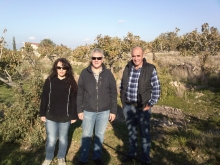
- The network lists were enriched (Action D1)
- IMS worked on the analysis of the requirements and the design of the Software Monitoring Tool (Action A4).
- TUC worked on : (i) Energy input-output calculations of relevant agricultural products (Action C1); (ii) Preliminary selection of input data for LCA modeling (Action C1); (iii) Screening and preliminary selection of suitable social-indicators for sustainable pistachio vera L. cultivation (Action C2).
October 2013
- GIS maps of water quality of Aegina (from the first sampling campaign) were uploaded on the web site.
- The web inventory was updated and more data and texts were uploaded (Action D1)
- SSIA prepared the experiments for the assessment of compost phytotoxicity as well as the greenhouse experiments of Action A3.
- Ten representatives Greek soil were selected considering pH value, texture, organic matter content, salinity, and CEC and the experiments to assess the effect of pistachio waste on different soil types will begin in November 2013 (Action A3).
- IMS, carried out additional actions on the web site for account creation and forum posts (Action D1).
- Software monitoring tool requirement analysis continues (Action A4).
- Software monitoring tool design analysis initiated (Action A4).
- LCA: Energy input-output calculations of relevant agricultural products (Preliminary results-Action C1).
- Preliminary set up of input data for LCA modeling using available open-source software by TUC (Action C1).
- Review of existing literature on suitable social-indicators for sustainable pistachio vera L. cultivation that have been adopted in other Mediterranean countries (Action C2).
September 2013
August 2013
- SSIA organized two sampling campaigns in Aegina. In specific, the team of Dr. S. Theocharopoulos visited Aegina on 29 July until 2 August in order to collect soil and leaves samples for the creation of the Soil Suitability Maps (Action A3). The second team, which was consisted of Dr. V. Kavvadias and Prof. A. Assimakoopoulou, visited Aegina between 28-30 August for leaves collection in order to assess phytotoxicity due to cultivation practices and
 wastes disposal on soil (Action A2). Photos from leaves collection.
wastes disposal on soil (Action A2). Photos from leaves collection.
- Creation of GIS maps for soil and water quality parameters which represent the initial situation of the pilot area and will be used in the framework of action C1 and also to feed the inventory of the web site.
- Dissemination material was designed and is under production (Action D1)
- Additional website management actions were carried out by IMS (Action D1).
- IMS started the design of the prototype software monitoring tool (Action A4).
- TUC performed detailed review in the framework of Action C1 of:
- existing literature for identifying suitable integrated scenarios for sustainable P. vera L. cultivation that have been adopted in other Mediterranean countries.
- existing methods for reduction of expenses (e.g. pesticides, chemical fertilization, irrigation water) related to agricultural production such as pistachio vera L. cultivation.
- LCA
July 2013
- One of the two sampling teams of SSIA visited Aegina between 1-5 July and collected soil and water samples for Action A2 (180 soil samples and 14 water samples were collected).
- Almost 100Kg of pistachio wastes were collected and transferred at SSIA’s premises to be used for the cultivation experiments of Action A3.
- The pilot composting resulted in the definition of an optimum ratio of raw materials and now the responsible team will proceed with the production of larger compost amounts. Tests with the use of clinoptilolite will take place as well.
- The results of the soil and water samples analysis were studied, evaluated and introduced to GIS-LIS.The data were also statistically analyzed and processed by different geostatistical techniques in order the initial draft maps to be compiled (Action A2).
- Additional website management actions were performed (Action D1)
- Inventory catalogs schema updated (Actions A1 and D1).
- Newsletter support and subscription actions added (Action D1)
- Photo library material updated, multilingual support added
- Improvement in web site design and layout (Action D1).
- Collection and interpretation-analysis by TUC of raw LCA data from filled questionnaires concerning relevant Greek agricultural products (apple, cotton etc). Preliminary energy input-output calculations are being conducted – comparative study (Actions C1 and C2).
- Informative material regarding the objectives and the expected results of the Agrostrat was distributed by Prof. K. Komnitsas to the participants of two International Conferences in Italy and in Turkey (Action D1).
- The English questionnaire of Action C1 regarding LCA of Pistachio vera L. has been also distributed via e-mail to scientists conducting related scientific research in agricultural associations in other countries. In the line of Action A1, TUC continues the collection of data regarding Aegina island.
June 2013
- One of the two sampling teams of SSIA visited Aegina between 17-21 June and collected soil and water samples for the development of the GIS maps (Action A2). See photos from soil mapping campaign here
- Composting experiments were continued (Action A3).
- Data collected so far are processed
- The Inception Report was submitted on 15 June 2013 (Action E1).
- Web site: Data collection and import for the Inventories is almost completed (Action D1).
- Inventory catalogs are made public available (Actions A1 and D1).
- On-line questionnaires are completed with integrated multilingual support (Actions A1, C1, C2).
- TUC continued the collection of data regarding Aegina island (Action A1).
May 2013
- AGROSTRAT organized a workshop in Aegina on 23 May in order to present AGROSTRAT to the local community and farmers (Action D1). Download the invitation (in Greek); the programm of the workshop in Aegina (in Greek);the poster (in Greek);
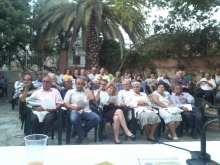 watch the video here
watch the video here
- The IMS team worked on the support of web site inventory (Actions A1 and D1)
- The TUC team worked also on the existing methods for reduction of expenses (e.g. pesticides, chemical fertilization, irrigation water) related to agricultural production such as pistachio vera L. cultivation (Action C1).
April 2013
March 2013
- The team of SSIA (Dr. Doula, Dr. Kavvadias, Mr. Tountas, Mr. Dimopoulos, Mr. Tsoutsikos) visited Aegina on 4 March for soil, water and wastes samples collection (Action A2).
- The second team of SSIA, which is responsible for the development of the GIS maps and the Land Suitability Map (leader Dr. Theocharopoulos, Ch. Kolovos, Mr. Tountas and Mr. Tsoutsikos) traveled to Aegina on 11 March for 5 day for soil sampling. They collect almost 150 soil samples for soil mapping and 10 water samples.
- A Meteorological Station was leased and will be transferred to Aegina by the end of March (Actions A2, A4, B1 and B2).
- Composting experiments begun (Action A3). Apart from pistachio wastes, other raw materials were used as well (straw, sheep and goat manure, pistachio wood cells, leaves).
- The IMS team continued the construction of the website (Action D1) adding multi-language support and translations (EN-GR).
- In the line of Action C2 the TUC team also focused on the preliminary identification of the particular socio-economical characteristics of the Aegina island with emphasis given on farmers.
- AgroStrat Newsletter release
February 2013
- SSIA prepared two questionnaires (in Greek and in English, one for pistachio producers and one for the public) for Action A1, one for citizens and one for farmers.
- TUC prepared also a preliminary questionnaire concerning social-economic impact of pistachia vera. L cultivation, adapted to the different target audiences (Action C2).
- The team, which is responsible for the development of the GIS maps and the Land Suitability Map (leader Dr. Theocharopoulos) collected data for the preparation of field work for soil mapping, classification, evaluation and description of degradation state of Aegina soils, they designed Aegina Land Resources Data Base in order to store and process project data and produce the deliverables and finally processed and digitalized the primary analogue data of Aegina in order to get prepared for the field work for the basic soil map of Aegina (Action A2).
- On 12 February, a Technical Committee, between SSIA and IMS took place at IMS’ premises for the discussion of the materialization of the field measuring tool, the way that the management software will be materialized and the type of inventories that will be also implemented in the Web site.
- The logo of the project is ready (Action D1)
- The web site of the project is ready (Action D1)
January 2013
- For the better execution of project activities SSIA formed three teams with leaders: Dr. M. Doula (coordinator, responsible for the activities: action A1, soil/water monitoring, soil indicators and composting); Dr. V. Kavvadias (responsible for developing integrated cultivation practices, parameterization of software, phytotoxicity tests) and Dr. S. Theocharopoulos (responsible for the GIS maps, the Land Suitability System and the desertification risk assessment).
- IMS team (Dr. Apostolos Sarris, Angelos Chliaoutakis, Aris Kydonakis) analysed the requirement for the AgroStrat website based on project description. The domain name (www.agrostrat.gr) was registered and physical hosting on IMS web server was allocated. The setup on staging server was completed (Action D1).
- The construction of the website backend (Content Management System - CMS) has begun and various modules according to requirement analysis were integrated. User accounts/permissions for accessing website CMS were created. The website design and layout construction is under development (Action D1).
- In the line of Action A2, the team of SSIA (Dr. Doula, Dr. Kavvadias, Mr. Tountas and Mr. Tsoutsikos) visited Aegina on 29 January to collect soil samples (1st sampling campaign). They cooperated with local farmers and Mrs Assimakopoulou, who traveled also to Aegina, and finally 15 fields were selected for periodical soil monitoring.
- The team of TUC ( Prof. K. Komnitsas, Prof. Vamvouka, Dr. G. Bartzas, Dr. S. Papamarkou and Dr. D.Zaharaki) collected data concerning Aegina Island:Topics maps of Special Protection Areas, Corine Land Cover, Cartographic background and Naura/Corine sites (Action A1).
- - Cultivation practices, use of pesticides, composting activities, recycling of agricultural wastes, etc
- - Analytical meteorological data of the wider area (continued from previous month)
- - Water-quality characteristics of main streams and reservoirs (continued from previous month)
- - Type of companies, production procedures and technical characteristics of production and disposal routes (continued from previous month)
- - Initial impact assessment of wastes disposal and management of soil and water bodies (continued from previous month)
-
- In the line of Action C1, TUC performed Literature review of the existing protocols and methodologies concerning Carbon Footprint of agricultural products; review of existing methodologies and databases for conducting Life Cycle Analysis (LCA) for agricultural products
2012
December 2012
- Between 5 and 7 December, representatives of the SSIA team (Doula, Kavvadias, Theocharopoulos) visited Aegina. Two representatives of the Region of Attiki (Rafti, Chatziperi) joined the group also. During the visit, the team contacted pistachio producers and also Mr Alifantis (the president of the Agricultural Association of Aegina), discussed issues on soil/water sampling and visited many fields and also other areas of interest (water bodies, wastes disposal areas) and performed preliminary geomorphological assessment of the area. On 6 December, the team visited the Mayor of Aegina to inform him regarding the AGROSTRAT project. He agreed to cooperate and nominated a contact person from the Municipality. Contacts and discussions with local societal groups took also place (Actions A1 and A2).
- SSIA collected ortho-photos from the Ministry of Rural Development, Direction of Topography,map with the registered fields of Pistachia vera which are subject to subsidies through the Ministry of Rural Development (OPEKEPE), the geological Map at a scale of the area as well as different studies performed so far of the island (Action A1).
- TUC focused on characteristics of the hydro-geomorphology of Aegina, meteorological data, water-quality characteristics of main streams and reservoirs, local population figures and activities, type of companies, production procedures and technical characteristics of production and disposal routes, initial impact assessment of wastes disposal and management of soil and water bodies (Action A1).
- IMS focused on the internet source and identify many studies and references on the subject (Action A1).
- AGROSTRAT was presented during the last workshop of PROSODOL on 21 December 2012.
October/November 2012
- Project started on 1st October 2012
- In the framework of Αction A1, the beneficiaries collected data from different sources to develop the Aegina web-inventory and the Study “Assessment of Environment Status of the pilot area”
- The Institute of Mediterranean Studies worked on the design of the project web site (Action D1).
- A newsletter was sent to internet Greek newspapers and internet sites relative to Aegina and to Agriculture. Many other sites in the entire country reproduced the newsletter (Action D1).
- The Agrostrat participated (Dr. M. Doula and Dr. S. Theocharopoulos) in the kick off meeting of the 2011 LIFE projects on 15 November 2012.
- The kick of meeting of the project took place at SSIA’s premises on 27 November 2012 with the presence of all Beneficiaries, of the representative of the external monitoring team (Dr. G. Valaora) and of representatives of the Regional Authority of Attiki.
- SSIA team will visit Aegina island between 5 and 7 December and this visit was prepared during November 2012.

providing users a user friendly interface, in order to store the location coordinates as data for each of their fields (Action A4).

results and discussed with the participants on different issues regarding P. vera L cultivation, water quality, soil degradation and waste management. On 21 September the project organized a composting training workshop to present and explain the way of successful composting of pistachio wastes (Action D1).
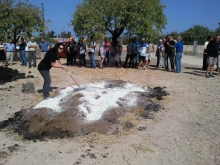 (Action C1).
(Action C1).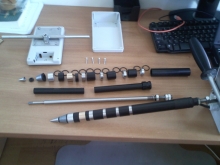 N.Papadopoulos) and discussed issues regarding the field equipment. The equipment was tested in real time operation (Action A2).
N.Papadopoulos) and discussed issues regarding the field equipment. The equipment was tested in real time operation (Action A2).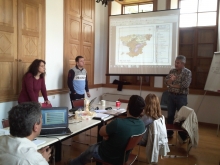
 The coordinator visited the pistachio producers in Fhtiotida prefecture (two associations) and presented project’s aims. The two associations were satisfied from the anticipated outcomes and expressed their interest to implement the software that will be developed. It is also agreed to visit together with the coordinator and the team Leaders of IMS and TUC the Regional Governor to present the project and ask his support for the implementation of AgroStrat also in Fthiotida.
The coordinator visited the pistachio producers in Fhtiotida prefecture (two associations) and presented project’s aims. The two associations were satisfied from the anticipated outcomes and expressed their interest to implement the software that will be developed. It is also agreed to visit together with the coordinator and the team Leaders of IMS and TUC the Regional Governor to present the project and ask his support for the implementation of AgroStrat also in Fthiotida.

wastes disposal on soil (Action A2). Photos from leaves collection.
 watch the video here
watch the video here